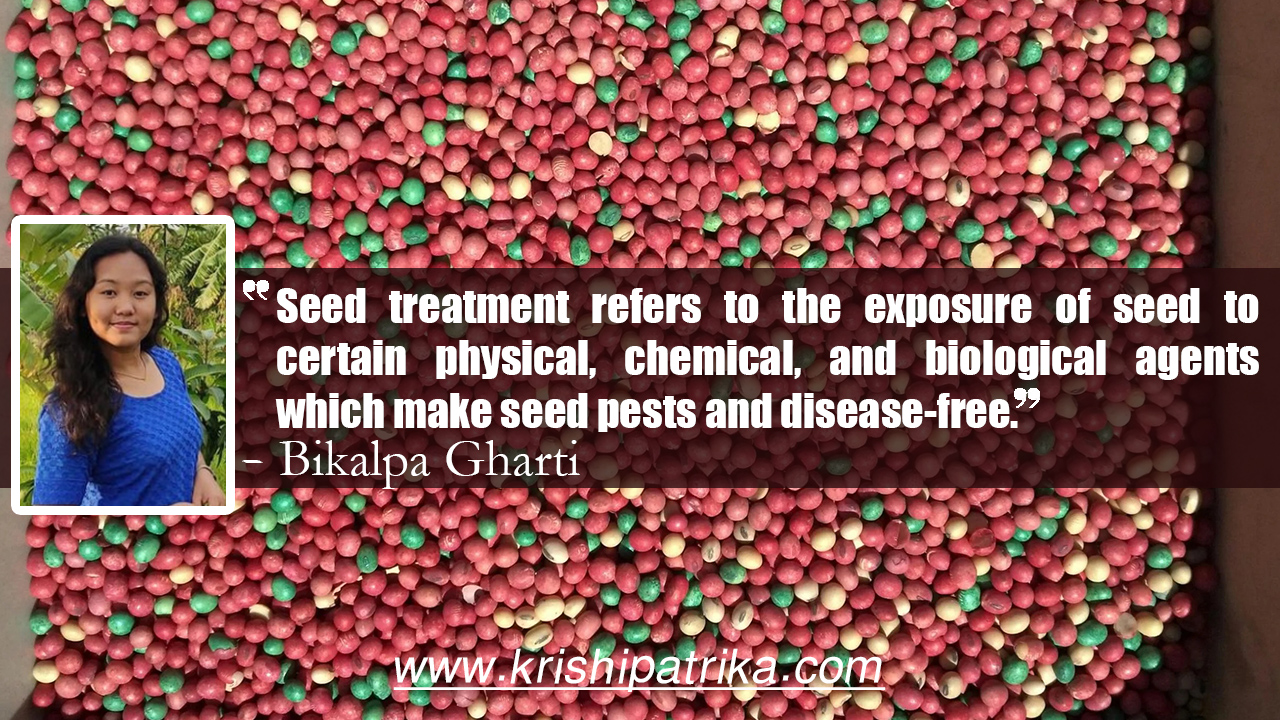
Seed can be defined as a fertilized mature ovule that is enclosed in a protective testa (outer covering) possessing endosperm as food material and is an embryonic plant. Quality seed is viable and has the capacity to germinate. The role of seed in the agriculture sector is of prime importance in developing and agricultural countries like Nepal where about 66% of people are engaged in agriculture. To obtain an optimum yield, farmers need to have quality seeds. Quality of seed is maintained by various environmental factors such as temperature, moisture, humidity, etc. but sometimes the quality of seed is reduced by various seed borns, soil-borne disease, and some insects and pests. Seed treatment can be one of the effective methods to maintain quality seed.
Seed treatment is the process of treating seed one week or 24 hours before sowing to overcome loss due to natural and unforeseen infection. Seed treatment refers to the exposure of seed to certain physical, chemical, and biological agents which make seed pests and disease-free. Using seed treatments has become popular in commercial agriculture. It also provides the possibility of pest and disease control. It plays an important role in sustainable crop production and also helps to improve the yield of many different crops by protecting pre and post-emergence insects and diseases and insurance of a uniform stand across a wide variety of soil types, cultural practices, and environmental conditions.
Importance of seed treatment
- Control diseases such as seed born, airborne, and soil-borne
- Control of insects and pests such as aphids, ants, whitefly, etc.
- It increases seed vigor which is key to successful crop stand establishment.
- It improves seedling emergence.
- Increases nitrogen fixation and yield.
- Seeds are protected during storage and also after planting in the soil.
Types of seed treatment
1.Insecticides and fungicides treatment
Fungicide treatment eradicates the fungal spores that might be developed within the seed coat. Triticonazole, thiram, captan, etc can be used for fungicide treatment. Insecticide treatments are applied to seeds to control and reduce insect infestations during storage. Seeds are protected from various diseases and pests and also provide protection against many seeds and soil-borne pathogens with the help of insecticides and fungicides treatment. It also prevents farmers from using excessive insecticides and pesticides on the plant itself. Fungicidal treatment can be divided into three categories.
- Seed disinfection
- Seed infestation
- Seed protection
2.Microbial inoculants
It helps to improve biological nitrogen fixation in legume crops and also increases soil biodiversity. Inoculants help to increase crop yields by enhancing the biodiversity of the soil with beneficial microorganisms. Generally, seeds are inoculated with rhizobium species and phosphorus solubilizers, mycorrhizal fungi, etc. Rhizobium inoculation increases the population of rhizobium spp (nitrogen fixer) and microbial activity in the rhizosphere whereas inoculation with phosphate solubilizer helps to convert the insoluble form of phosphate into a soluble form and increases phosphorus availability to the roots and crops.
3. Fertilizers
It is one of the important seed treatment methods. This treatment promotes plant growth by improving fertilizer performance and by supplying micronutrients to the soil. Fertilizer treatment increases seed vigor and improves seed quality which encourages successful crop stand establishment.
4. Seed scarification
It is one of the seed treatment methods which facilitates quick germination in seeds. Such treatments soften the seed coats of the seed which allow imbibition of water and gases inside the seed and hence promote rapid growth. Seed scarification has been proved as an effective method for enhancing seed germination. There are various methods of seed scarification; Acid scarification, Mechanical scarification, Boiled water scarification, Stratification.
5. Seed hardening treatments
The seed hardening treatments are mostly used to help seeds to withstand initial drought and cold. Cold tolerance treatments are given to temperate crops.
The important factors that need to be considered during treatments are
- Seed: solution ratio (1:1)
- Duration of soaking
- Method of drying
The amount of solution should not be in a higher proportion than that of seed. Once seeds imbibe all the solution, a germination process takes place then seeds should be dried at an original moisture content at the end of the soaking period.
6. Seed fortification
The main objective of seed fortification is to supply nutrients to the seed. It helps to achieve high vigor in order to overcome unfavorable conditions of soil and environment. Generally, it improves the oxidation-reduction potential of seeds, which ultimately leads to higher germination.
7. Seed pelleting
In this method, nutrients are coated on the seed. Normally seed pelleting is done in small-sized seeds. With the help of this method, we can increase the size of the seed and we can also reduce the seed rate. For pelting, we can use inert materials( lime, chalk) and plant products such as neem, Arappu, etc. which are found to possess growth promoters.
8. Osmotic priming
Osmotic priming is the process of making seeds to imbibe water slowly. Poly ethyl glister(PEG) is used as osmotic priming which is inert in nature and imbibes water slowly into seeds. Seeds are invigorated by osmotic priming, resulting in uniform, early, and greater field emergence and seedling vigor.
Conclusion
Overall seed treatment is very important as it hastens seed germination and improves crop productivity. Seed treatment approaches have been used to reduce seedling emergence time, improve stand establishment and yield under a wide range of environmental conditions. It is one of the best solutions for germination-related problems during unfavorable soil and environmental conditions and also promotes the market value of the seed.











